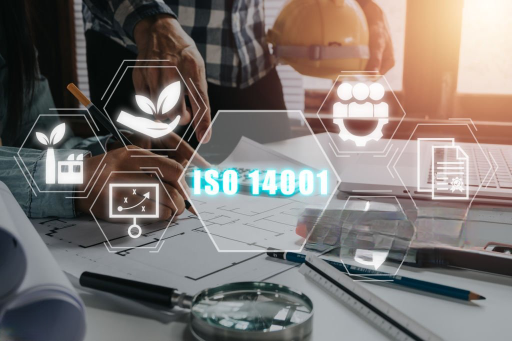I. Introduction to ISO 14001 Certification
A. Overview of ISO 14001 and Its Role in Environmental Management
ISO 14001 is a globally recognized standard that establishes the framework for effective environmental management systems (EMS). Its primary goal is to help organizations minimize their environmental impact while improving operational efficiency. By implementing ISO 14001, organizations can systematically identify, manage, and reduce environmental risks associated with their activities. The standard covers various aspects of environmental management, including resource utilization, waste management, and pollution prevention. ISO 14001 encourages organizations to take a proactive approach to environmental stewardship, fostering sustainable practices that align with regulatory requirements and societal expectations. By adhering to this standard, organizations can demonstrate their commitment to environmental responsibility and enhance their ability to meet both internal and external environmental goals.
II. Steps to Achieve ISO 14001 Certification
A. Conducting an initial environmental review and gap analysis
The journey toward ISO 14001 Certification begins with a thorough environmental review and gap analysis. This process involves assessing the current environmental impact of your organization’s activities, products, and services. By identifying areas where your environmental practices fall short, you can determine the necessary improvements needed to meet ISO 14001 standards. The gap analysis is a crucial step as it highlights the specific areas that require attention, such as waste management, energy use, or compliance with environmental regulations. This evaluation not only sets the baseline for your Environmental Management System (EMS) but also helps in prioritizing actions that will have the most significant impact on reducing your environmental footprint.
B. Developing and Implementing an Environmental Management System (EMS)
Once the initial environmental review and gap analysis are complete, the next step is to develop and implement a robust Environmental Management System (EMS). The EMS serves as the framework for managing your organization’s environmental responsibilities in a systematic and consistent manner. It involves establishing environmental objectives, defining processes and procedures to achieve these objectives, and assigning responsibilities across the organization. Key elements of an effective EMS include documentation, training, communication, and continuous monitoring of environmental performance.By integrating the EMS into your daily operations, you ensure that environmental management becomes a core part of your organizational culture, leading to sustained improvements and compliance with ISO 14001 standards.
C. Preparing for the Certification Audit and Ensuring Compliance
The final step in achieving ISO 14001 Certification is preparing for the certification audit. This involves a comprehensive review of your EMS to ensure that it meets all the requirements of the ISO 14001 standard. Key documentation, such as environmental policies, procedures, records, and reports, should be well-organized and readily accessible. Conducting internal audits and management reviews can help identify any remaining non-conformities and address them before the external audit. During the certification audit, an external auditor will assess your organization’s compliance with ISO 14001, focusing on the effectiveness of your EMS and its implementation.Successfully passing the audit not only results in certification but also demonstrates your organization’s commitment to environmental stewardship and continuous improvement.
III. ISO 14001 Certification and Stakeholder Engagement
A. Involving Stakeholders in Environmental Management Initiatives
Effective environmental management under ISO 14001 involves more than just internal efforts; it requires the active participation of various stakeholders, including employees, suppliers, customers, and regulatory bodies. Engaging these groups in your environmental initiatives ensures that diverse perspectives are considered and that everyone understands their role in supporting sustainability goals.Stakeholder involvement can range from seeking input during the development of environmental policies to collaborating on projects that reduce environmental impact.By fostering a collaborative approach, your organization can create a more comprehensive and effective Environmental Management System (EMS) that aligns with the expectations and needs of all parties involved.
B. The Importance of Transparency and Reporting in ISO 14001
Transparency and clear reporting are fundamental to the success of ISO 14001 Certification. Regularly communicating your environmental performance, goals, and progress to stakeholders demonstrates accountability and builds credibility. Reporting can take various forms, including annual environmental reports, sustainability reports, or specific updates on significant environmental initiatives. Transparent reporting not only fulfills regulatory requirements but also enhances trust with stakeholders, who can see firsthand the efforts your organization is making to improve its environmental performance. It also provides a platform for stakeholders to offer feedback and contribute to the continuous improvement of your environmental management practices.
C. Building Trust with Customers and the Community Through ISO 14001
Achieving ISO 14001 Certification can significantly enhance your organization’s reputation among customers and the broader community. By adopting and effectively implementing an Environmental Management System, you signal your commitment to responsible environmental stewardship. This commitment can lead to increased customer loyalty, as consumers increasingly prefer to do business with environmentally conscious companies. Furthermore, being proactive in environmental management can help build stronger relationships with the community, demonstrating that your organization is a responsible corporate citizen. The trust and goodwill gained through ISO 14001 Certification can differentiate your organization in the marketplace, leading to long-term benefits and a positive public image.
IV. Continuous Improvement with ISO 14001 Certification
A. The Importance of Ongoing Improvements in Environmental Management
Sustaining ISO 14001 Certification requires a commitment to continuous improvement in environmental management. This principle ensures that your Environmental Management System (EMS) remains dynamic and responsive to new challenges and opportunities. Continuous improvement involves regularly evaluating and enhancing your processes to reduce environmental impact, improve efficiency, and align with evolving regulatory standards. This ongoing effort not only helps in maintaining compliance but also positions your organization as a leader in environmental stewardship. By embracing a culture of continuous improvement, your organization can achieve long-term sustainability and stay ahead of competitors in an increasingly eco-conscious market.
B. Measuring and Reporting Progress Under ISO 14001
To ensure that continuous improvement efforts are effective, it is crucial to measure and report progress under ISO 14001. Establishing clear metrics and key performance indicators (KPIs) allows your organization to track environmental performance over time and assess the impact of specific initiatives. Regular reporting not only demonstrates compliance with ISO 14001 standards but also provides transparency to stakeholders, showcasing your commitment to environmental responsibility. By systematically measuring and reporting progress, your organization can identify successes, pinpoint areas for further improvement, and communicate achievements to customers, regulators, and the community, thereby reinforcing your position as a responsible and sustainable business.
V. Conclusion: The Future of ISO 14001 Certification
A. Emerging trends in environmental management and their impact on ISO 14001
As the field of environmental management continues to evolve, new trends are emerging that significantly impact the implementation and effectiveness of ISO 14001 Certification.Increasing emphasis on climate change mitigation, resource efficiency, and circular economy principles is driving organizations to adopt more comprehensive and proactive environmental strategies.Advancements in technology, such as the use of big data, artificial intelligence, and IoT in monitoring and managing environmental performance, are also reshaping how companies approach their Environmental Management Systems (EMS).These trends are not only enhancing the capabilities of ISO 14001 but also pushing organizations to continuously update their practices to remain compliant and effective in reducing their environmental footprint.Staying attuned to these developments ensures that your organization remains at the forefront of environmental management and sustainability.



